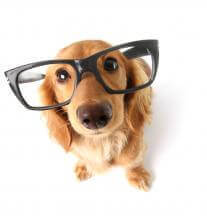Doggy Intelligence
Are some breeds smarter than others? Do doggy IQ tests really measure canine intelligence? What’s a fair way to judge dogs’ brains? The Dog Trainer delves into the fray.
Jolanta Benal, CPDT-KA, CBCC-KA
Listen
Doggy Intelligence

First, let’s get one thing straight: My dog Juniper is the smartest, the cutest and, unfortunately, the most flatulent. Okay?
With that taken care of, here’s a little tour of doggy intelligence tests and lists of the smartest and least-smart dog breeds. Word of caution about what this episode isn’t: a survey of scientific research on dogs’ cognitive abilities. I’m going for easy prey here, in the form of the good old “It must be true because I saw it on the Internet.”
.
What Do Doggy Intelligence Tests Really Measure?
As you may know, many critics have argued that IQ tests for humans are biased and don’t measure what they claim to measure. Human assessments of dogs’ intelligence – well, I would call them lame, though hopefully they have less pernicious effects.
The Towel Test
Check out a couple of items on one common test, just as an example. The test starts by having you put a towel over your dog’s head. His score on that item depends on how fast he gets the towel off him. But some dogs will hate having the towel on their heads and will be desperate to remove it, while other dogs don’t really care all that much. Is this about brains or about touchiness?
The Home Décor Test
Next up: a Stupid Human Trick. You take your dog out of the room where her favorite napping spot is, and then you rearrange the furniture. Clearly, this is a dog IQ test for people with a lot of time on their hands. Having recovered from your faint when you see all the dust bunnies, you bring your dog back in and see how long it takes her to find her favorite spot again. Dogalini gets the most points if she heads right for that spot. She loses a point if she explores for 30 seconds. She loses another point if she settles down in another spot altogether.
Incidentally, the test doesn’t explain whether “spot” means a bed or a particular piece of furniture, or whether “spot” means a particular location within the room. I’m going with the bed or piece of furniture, but your guess is as good as mine.
Now, I would wonder whether a dog who headed straight for her bed or straight for the sofa had failed to notice that there was something a little different about the place. And I would think that a dog who explored was interested in novelty, which sounds smart. And I would furthermore think that a dog who settled down in a different spot maybe just, well, liked the new spot better.
What Does It Mean for a Dog to Be “Intelligent”?

Does the room-rearrangement project really test whether your dog can find her bed in a rearranged room? Does speed of towel removal – even if you’re comparing dogs who are equally motivated by this task – have anything to do with a fair assessment of intelligence? And what is intelligence, if you’re a dog? Does it have to do with how quickly the dog responds to human cues? Or with how easily the dog learns human words?
Standards like those seem to assess dogs by how convenient they are to us. Maybe it makes more sense to measure a dog’s success in scavenging for food, or how quickly he finds his way to a female in heat. Hey, scientists can’t even agree on what “intelligence” should mean with respect to humans.
Which Breeds Are the Smartest?
This brings me to the idea that you can rank breeds by intelligence. “Smartest Breed” lists often order dogs on the basis of how impressive they are to humans, and specifically on how easy it is to teach them to perform tasks that people approve of. Border Collies always seem to turn up in the #1 slot, with other herding dogs and retrieving breeds also in the top 10.
What these breeds have in common is that they were developed to work closely with people and under human direction. Stanley Coren, author of The Intelligence of Dogs, relied on a survey of judges in the sport of competitive obedience to make his list. Sure, “cooperative and biddable” can easily coexist with “smart,” but they’re not the same thing.
I can’t be the only dog trainer to raise an eyebrow at the lowly rank Chihuahuas came in at in Coren’s survey: #62 of 79 breeds. I often find Chis skittish and shy, but I can’t say I’ve ever found them notably slow learners.
Training Methods May Affect How We Perceive “Intelligence”
It’s also worth pointing out that Coren compiled his list in the mid-1990s, when harsh physical methods of dog training were almost everywhere the norm. Even now, competitive obedience is one neighborhood of Dog Land that hasn’t quite got on the modern positive-reinforcement bus. And while I can’t prove it scientifically, it’s certainly my impression that “hard to teach” in that old-school collar-jerking way looks an awful lot like “doesn’t respond well to coercion.”
I said this episode wasn’t going to discuss the serious research on cognition in dogs and other animals, but before I close up shop, let’s take a moment for the mirror test. The point of a mirror test is to find out whether an animal recognizes itself in a mirror. Self-recognition is taken to be a sign of self-awareness. Most adult humans obviously pass the mirror test, and so do a number of other primate species. Dogs don’t. And that’s a gorgeous example of why human-centered notions about intelligence and awareness may not help us much when applied to dogs.
Why? Dogs’ visual acuity – what eye charts test – is much worse than ours, and dogs have a much more limited range of binocular vision than we do. (Some brachycephalic breeds, with their eyes at the front of their heads instead of set off to the side, have better binocular vision than dogs whose physical form is more normal for the species.) Long story short, dogs may or may not have self-awareness, but a visual test is not the way to find out. So what is?

The answer, if there is one, lies beyond the reach of this podcast, but it might be scent-based. Here’s your takeaway: There’s some evidence that dogs recognize their own urine. Betcha you can’t do that, you poor non-self-aware weak smeller, you.
As always, you can write to me at dogtrainer@quickanddirtytips.comcreate new email. I get so many questions that I can’t respond individually, but check out past episodes – I might already have answered yours, especially if it’s about housetraining, humping, or aggression. And please visit me on Facebook, where I’m The Dog Trainer.
Betterment LLC is an SEC Registered Investment Advisor. Brokerage services are offered by Betterment Securities, an SEC registered broker-dealer and member FINRA/SIPC. Investments are not FDIC Insured. No Bank Guarantee. May Lose Value. Investing in securities involves risks, and there is always the potential of losing money when you invest in securities. Before investing, consider your investment objectives and Betterment’s charges and expenses. Not an offer, solicitation of an offer, or advice to buy or sell securities in jurisdictions where Betterment and Betterment Securities are not registered.
Dog in glasses and dog counting images courtesy of Shutterstock.

